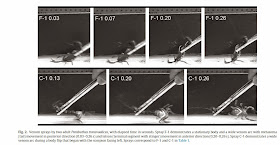This blog will list news about all aspects of scorpion biology and important taxonomical updates from The scorpion Files. The Scorpion Files is a leading information source about scorpions, and has among others an updated list of all extant families, genera and species.(C) Jan Ove Rein and The Scorpion Files.
24 March, 2015
Venom spraying in scorpions
It is well known that scorpions use venom in prey capture and defense. This is normally done by injecting venom thought the scorpion's stinger. It is less known that a few species also can spray venom up 50 cm away. This behavior has only been reported from seven species in the South African genus Parabuthus Pocock, 1890 (Buthidae). It has been assumed that the venom spraying behavior has an anti-predator effect against potential predators of scorpions. Getting venom spray into the eyes is probably also harmful for humans, as many Parabuthus scorpions are of medical importance.
Nissani and Hayes have now published a very interesting analysis of the venom spraying behavior in Parabuthus transvaalicus Purcell, 1899, a medical important species from South Africa. Their study supported the hypothesis that that P. transvaalicus modulates venom spraying depending on level of threat. The authors argue that venom spraying increase the likelihood that venom makes contact with sensitive tissues of the predator, particularly its eyes. The authors believe that there is a possibility that scorpions modulate the quantity of venom expelled during spraying, but this requires further investigations.
Abstract:
Many animals use chemical squirting or spraying behavior as a defensive response. Some members of the scorpion genus Parabuthus (family Buthidae) can spray their venom. We examined the stimulus control and characteristics of venom spraying by Parabuthus transvaalicus to better understand the behavioral context for its use. Venom spraying occurred mostly, but not always, when the metasoma (tail) was contacted (usually grasped by forceps), and was absent during stinging-like thrusts of the metasoma apart from contact. Scorpions were significantly more likely to spray when contact was also accompanied by airborne stimuli. Sprays happened almost instantaneously following grasping by forceps (median = 0.23 s) as a brief (0.07 - 0.30 s, mean = 0.18 s), fine stream (< 5 * arc) that was not directed toward the stimulus source; however, rapid independent movements of the metasoma and/or telson (stinger) often created a more diffuse spray, increasing the possibility of venom contact with the sensitive eyes of potential scorpion predators. Successive venom sprays varied considerably in duration and velocity. Collectively, these results suggest that venom spraying might be useful as an antipredator function and can be modulated based on threat.
Reference:
Nisani Z, Hayes WK. Venom-spraying behavior of the scorpion Parabuthus transvaalicus (Arachnida: Buthidae). Behavioural Processes. 2015 Mar 3;115:46-52. [Subscription required for full text]

No comments:
Post a Comment